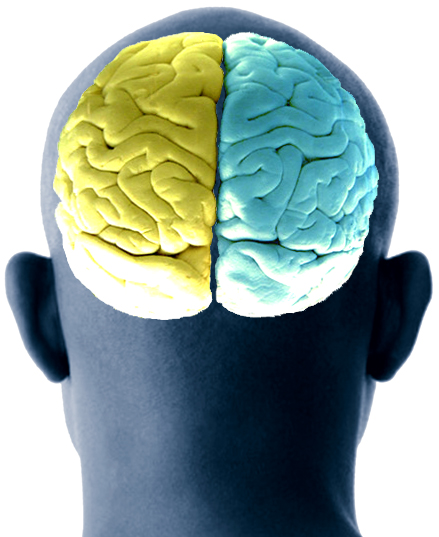What kind of thinker are you?
Take the quiz now.
It is operated by an independent website not affiliated with Seaward
Corp. We do not capture or save any data related to the quiz.
actionable
motivational
visual
evaluative
analytical
interpretive

Left/Right Brain Explained
The history of brain lateralization goes back to the Nobel Prize winners, Roger Sperry and Robert Ornstein who coined the term approximately forty years ago. They developed the theory of brain lateralization to help us to understand our behavior, our personality, our creativity, and our ability to use the proper mode of thinking when performing particular tasks.
Is the human brain one organ or two organs working as one? The human brain is split into two cerebral halves that are joined together by the Corpus Callosum.
The two hemispheres of the brain look alike but fulfill different functions. The cerebral cortex is an area of the brain that only exists in human and other higher mammals to manage sophisticated intellect and tasks. Women tend to have more active corpus callosum with 10% more neuron fibers. The corpus collosum is up to 40 percent larger in women compared to men. (Stout)
Each hemisphere has specific functions that it carries out. The left hemisphere concentrates on hard facts: abstractions, structure, discipline (rules), time sequences, mathematics, categorizing, logic and rationality and deductive reasoning. The left hemisphere also deals with knowledge, details, definitions, planning and goals, words (written, spoken, and heard), productivity and efficiency, science and technology, stability, physical activity. (Stout)
The right hemisphere specializes in the “softer” aspects of life. This includes intution, feelings and sensitivity, emotions, daydreaming and visualizing, creativity (including art and music), color, spatial awareness, first impressions, rhythm, spontaneity and impulsiveness, humor, motor skills. The right side also focuses on a holistic way of perception that recognizes patterns and similarities and then synthesizes those elements into new forms. (Stout)
The left and right hemisphere also have shared functions such as sensations on both sides of the face, sound perceived by both ears, pain, hunger, and position.
The left side of the brain controls the right side of the body and the right side of the brain controls the left side of the body.
Below is a chart that illustrates what brain functions were discovered in particular years.
| Left | Right | |
| 1864 | Expression | Perception |
| 1874 | Audito-articular | Retino-ocular |
| 1876 | Propositionizing | Visual imagery |
| 1935 | Linguistic | Visual or kinesthetic |
| 1951 | Storage | Executive |
| 1951 | Symbolic or propositional | Visual or imaginative |
| 1952 | Education of relations | Education of correlates |
| (abstract reasoning) | (analogic reasoning) | |
| 1958 | Verbal | Perceptual or non-verbal |
| 1960 | Discrete | Diffuse |
| 1961 | Symbolic | Visuospatial |
| 1963 | Linguistic | Pre-verbal |
| 1965 | Verbal | Visuospatial |
| 1968 | Logical or analytic | Synthetic perceptual |
| 1969 | Propositional | Appositional |
| 1976 | Parts | Whole |
| 1977 | Language | Non-language |
Although each hemisphere controls different functions both sides work together in order for us to carry out tasks. For example, when we are playing a friendly game of softball (a right hemisphere activity), we would lose the essence of the game – the fun—if we were overly apprehensive regarding left-hemisphere matters such as rules and discipline. (Stout)
When a function is lateralized, this often means that one side of the brain exerts more control over this function than the other does. The side that exerts more control is often called the “dominant hemisphere” for this function, but this expression can be somewhat misleading. (Dubuc, 2002) We use one half, the dominant half more than the other.
Brain dominance is developed in our childhood years. The decision of which side of our brain will become the dominant side is influenced by your genetics, childhood experiences, and family environment. Dominance however is not total, despite which side of our brain that is dominant the other side is a big contender in carrying out our functions.
Brain dominance can also be used in terms of which side is dominant in performing certain tasks. For example, it appears that the right brain is dominant for spatial abilities, face recognition, visual imagery, and music. The left-brain may be more dominant for controlling tasks such as calculations, math, and logical abilities. (Chudler, 1996)
We tend to distrust or even dislike the non-dominant half. If we generally use our left hemisphere, we might be annoyed by our right hemisphere as though it were an undisciplined child; contrarily, a right hemisphere person might consider his or her left hemisphere to be a spoil-sport. (Stout)
The occupations in which we choose to pursue can also be influenced by whether or not we are a left or right-brained person. (Keep in mind there are always exceptions)
Occupations usually fulfilled by a left-brained person:
• Lab scientist
• Banker
• Judge
• Lawyer
• Mathematician
• Bacteriologist
• Librarian
• Skating judge, skiing judge, etc
Occupations usually fulfilled by a right-brained person:
• Forest ranger
• Wildlife manager
• Beautician
• Politician
• Athlete
• Artist
• Craftsman
• Actor/Actress
Although researchers have come very far in understanding human brain lateralization there is still much more to learn. There is still tremendous amounts of research that needs to be done in order to fully understand the relationship between the two hemispheres of the brain.
References
Castro, Elaine de, Untitled, 1998, Serendip,
http://serendip.brynmawr.edu/bb/neuro/neuro98/202s98-paper1/deCastro.html
Chudler, Eric H, One Brain...or Two?, 1996,
http://faculty.washington.edu/chudler/split.html
Dubuc, Bruno, Broca’s area, Wernicke’s area, and other language-processing areas in the brain, 2002,
http://thebrain.mcgill.ca/flash/a/a_10/a_10_cr/a_10_cr_lan/a_10_cr_lan.html
Gaburo, Kenneth, Brain:…Half a Whole, 1979-1980,
http://www.jstor.org
Holder, M.K What does handedness have to do with Brain Lateralization (and who cares?), 1995-2005,
http://www.indiana.edu/~primate/brain.html
Morris, Rich, Left Brain, Right Brain, Whole Brain?, 2005-2007,
http://www.singsurf.org/brain/rightbrain.php
Stout, James Harvey, Brain Lateralization,
http://www.theorderoftime.com/politics/cemetery/stout/h/brain-la.htm
